Scalidophora
Scalidophora is a group of marine pseudocoelomate protostomes that was proposed on morphological grounds to unite three phyla: the Kinorhyncha, the Priapulida and the Loricifera.[2][3] The three phyla have four characters in common — chitinous cuticle that is moulted, rings of scalids on the introvert, flosculi, and two rings of introvert retracts.[4] However, the monophyly of the Scalidophora was not supported by two molecular studies, where the position of the Loricifera was uncertain[2] or as sister to the Panarthropoda.[3] Both studies supported a reduced Scalidophora comprising the Kinorhyncha and Priapulida as sister phyla. Their closest relatives are the Panarthropoda, Nematoda and Nematomorpha; thus, they are placed in the group Ecdysozoa.
| Scalidophora | |
|---|---|
 | |
| Ottoia prolifica from the Walcott Quarry of the Burgess Shale (Middle Cambrian) near Field, British Columbia, Canada. | |
| Scientific classification | |
| Domain: | Eukaryota |
| Kingdom: | Animalia |
| Subkingdom: | Eumetazoa |
| Clade: | ParaHoxozoa |
| Clade: | Bilateria |
| Clade: | Nephrozoa |
| (unranked): | Protostomia |
| Superphylum: | Ecdysozoa |
| Clade: | Scalidophora Lemburg, 1995 |
| Phyla | |
| |
| Synonyms | |
|
Cephalorhyncha, Priapozoa | |
The two species in the genus Markuelia, known from fossilized embryos from the middle Cambrian, are thought to be stem Scalidophorans.
The group has also been considered a single group, Cephalorhyncha,[5] with three classes.
The group is named after the spines (scalids) covering the introvert (head that can be retracted into the trunk).[6]
References
- Harvey, T. H.; Dong, X.; Donoghue, P. C. (March–April 2010). "Are palaeoscolecids ancestral ecdysozoans?". Evolution & Development. 12 (2): 177–200. doi:10.1111/j.1525-142X.2010.00403.x. PMID 20433458. S2CID 16872271.
- Telford, M. J.; Bourlat, S. J.; Economou, A.; Papillon, D.; Rota-Stabelli, O. (27 April 2008). "The evolution of the Ecdysozoa". Philosophical Transactions of the Royal Society B. 363 (1496): 1529–1537. doi:10.1098/rstb.2007.2243. PMC 2614232. PMID 18192181.
- Yamasaki, Hiroshi; Fujimoto, Shinta; Miyazaki, Katsumi (2015-06-30). "Phylogenetic position of Loricifera inferred from nearly complete 18S and 28S rRNA gene sequences". Zoological Letters. 1: 18. doi:10.1186/s40851-015-0017-0. ISSN 2056-306X. PMC 4657359. PMID 26605063.
- Heiner, I., Kristensen, R.H. 2005. Two new species of the genus Pliciloricus (Loricifera, Pliciloricidae) from the Faroe Bank, North Atlantic. Zoologischer Anzeiger. 243: 121–138.
- Dirnberger, J. "Explanations and Difficulties in Invertebrate Phylogeny". Invertebrate Zoology. Kennesaw State University. Retrieved 2012-08-11.
- Dunn, C. W.; Hejnol, A.; Matus, D. Q.; Pang, K.; Browne, W. E.; Smith, S. A.; Seaver, E.; Rouse, G. W.; Obst, M.; et al. (10 April 2008). "Broad Phylogenomic Sampling Improves Resolution of the Animal Tree of Life". Nature. 452 (7188): 745–749. Bibcode:2008Natur.452..745D. doi:10.1038/nature06614. PMID 18322464. S2CID 4397099.